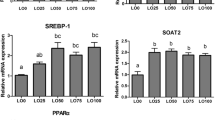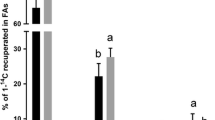Abstract
The oxidative stability of lipids from salmon roe and herring roe was compared with those of commercial fish oils originated from sardine and tuna. Both fish roe lipids contained high amounts of eicosapentaenoic acid (EPA) and docosahexaenoic acid (DHA). Total EPA and DHA was more than 35% of total fatty acids in both roe lipids. On the basis of oxygen consumption, fish roe lipids showed the higher oxidative stability than both fish oils. This tendency in oxidative stabilities was also confirmed by the determination of propanal formation during oxidation. Analyses of lipid compositions suggested that the higher oxidative stabilities of fish roe lipids would be mainly due to the presence of phospholipids in them. Dietary effects of salmon and herring roe lipids were also determined. Little increase in total cholesterol level was observed in plasma lipids in rats fed salmon and herring roe lipids, although cholesterol content in fish roe lipids were 6.3% and 9.7% of total lipids for salmon roe and herring roe.
Similar content being viewed by others
References
Tocher DR, Sargent JR. Analyses of lipids and fatty acids in ripe roes of some northwest European marine fish. Lipids 1984; 19: 492–499.
Cowey CB, Bell JG, Knox D, Fraser A, Youngson A. Lipids and lipid antioxidant systems in developing eggs of salmon (Salmo salar). Lipids 1985; 20: 567–572.
Cho S-Y, Miyashita K, Miyazawa T, Fujimoto K, Kaneda T. Autoxidation of ethyl eicosapentaenoate and docosa-hexaenoate. J. Am. Oil Chem. Soc. 1987; 64: 876–879.
Cho S-Y, Miyashita K, Miyazawa T, Fujimoto K, Kaneda T. Autoxidation of ethyl eicosapentaenoate and docosa-hexaenoate under light irradiation. Nippon Suisan Gakkaishi 1987; 53: 813–817.
Frankel EN. Antioxidants. In: Frankel EN (ed.). Lipid Oxidation. The Oily Press, Bridgewater. 1998; 129–160.
Ishikwa Y, Sugiyama K, Nakabayashi K. Stabilization of tocopherol by three components synergism involving tocopherol, phospholipid and amino compound. J. Am. Oil Chem. Soc. 1984; 61: 950–954.
Kashima M, Cha G-S, Isoda Y, Hirano J, Miyazawa T. The antioxidant effects of phospholipids on perilla oil. J. Am. Oil. Chem. Soc. 1991; 64: 119–122.
Hara S, Okada N, Hibino H, Totani Y. Antioxidative behavior of phospholipids for polyunsaturated fatty acids of fish oil. J. Jpn. Oil Chem. Soc. 1992; 41: 130–135.
King MF, Boyd LC, Sheldon BW. Effects of phospholipids on lipid oxidation of a salmon oil model system. J. Am. Oil Chem. Soc. 1992; 69: 237–242.
Ohshima T, Fujita Y, Koizumi C. Oxidative stability of sardine and mackerel lipids with reference to synergism between phospholipids and α-tocopherol. J. Am. Oil Chem. Soc. 1993; 70: 269–276.
Segawa T, Hara S, Totani Y. Antioxidative behavior of phospholipids for polyunsaturated fatty acids of fish oil. II. synergistic effect of phospholipids for tocopherol. J. Jpn. Oil Chem. Soc. 1994; 43: 515–519.
Segawa T, Kamata M, Hara S, Totani Y. Antioxidative behavior of phospholipids for polyunsaturated fatty acids of fish oil. III. synergistic mechanism of nitrogen including phospholipids for tocopherol. J. Jpn. Oil Chem. Soc. 1995; 44: 36–42.
Koga T, Terao J. Phospholipids increase radical-scavenging activity of vitamin E in a bulk oil model system. J. Agric. Food Chem. 1995; 43: 1450–1454.
Takeuchi M, Hara S, Totani Y, Hibino H, Tanaka Y. Antioxidative behavior of polyunsaturated phospholipids. I. oxidative stability of marine oil containing polyunsaturated phospholipids. J. Jpn. Oil Chem. Soc. 1997; 46: 175–181.
Saito H, Ishihara K. Antioxidant activity and active sites of phospholipids as antixoxidants. J. Am. Oil Chem. Soc. 1997; 74: 1531–1536.
Bandarra NM, Campos RM, Batista I, Nunes ML, Empis JM. Antioxidant synergy of α-tocopherol and phospholipids. J. Am. Oil. Chem. Soc. 1999; 76: 905–913.
Kaitaranta JK, Ackman RG. Total lipids and lipid classes of fish roe. Comp. Biochem. Physiol. 1981; 69B: 725–729.
Miyashita K, Inukai N, Ota T, Sasaki S, Ota T. Antioxidant activity of water extracts from fish eggs on PC liposomes. Nippon Suisan Gakkaishi 1999; 65: 488–494.
Li D, Bode O, Drummond H, Sinclair AJ. Omega-3 (n-3) fatty acids. In: Gunstone FD (ed.). Lipids for Functional Foods and Nutraceuticals. The Oily Press, Bridgewater, 2003; 225–262.
Shahide F, Miraliakbari H. Marine oils: compositional characteristics and health effects. In: Shahidi F (ed.). Nutraceutical and Specialty Lipids and their Co-products. CRS Taylor & Francis, Boca Raton, FL. 2006; 227–250.
Narayan B, Miyashita K, Hosokawa M. Physiological effects of eicosapentaenoic acid (EPA) and docosahexaenoic acid (DHA) — A review. Food Rev. Int. 2006; 22: 291–307.
Bligh EG, Dyer WJ. A rapid method of total lipid extraction and purification. Can. J. Biochem. Physiol. 1959; 37: 911–917.
Christie WW. Lipid Analysis. Pergamon Press, New York 1982.
Estévez M, Ventanas S, Ramírez R, Cava R. Analysis of volatiles in porcine liver pâtés with added sage and rosemary essential oils by using SPME-GC-MS. J. Agric. Food Chem. 2004; 52: 5168–5174.
Reeves PG, Nielsen FH, Fahey GC Jr. AIN-93 purified diets for laboratory rodents: final report of the American Institute of Nutrition ad hoc writing committee on the reformulation of the AIN-76A rodent diet. J. Nutr. 1993; 123: 1939–1951.
Richmond W. Preparation and properties of a cholesterol oxidase from Nocardia sp. and its application to the enzymatic assay of total cholesterol in serum. Clin. Chem. 1973; 19: 1350–1356.
Steele BW, Koehler DF, Kuba K, Azar MM. An enzymatic approach to lipoprotein quantification. Am. J. Clin. Pathol. 1980; 73: 75–78.
Hinsch W, Ebersbach WD, Sundaram PV. Fully enzymic method of plasma triglyceride determination using an immobilized glycerol dehydrogenase nylon-tube reactor. Clin. Chim. Acta 1980; 104: 95–100.
Cho S-Y, Joo D-S, Choi H-G, Nara E, Miyashita K. Oxidative stability of lipids from squid tissues. Fish. Sci. 2001; 67: 738–743.
Author information
Authors and Affiliations
Corresponding author
Rights and permissions
About this article
Cite this article
Moriya, H., Kuniminato, T., Hosokawa, M. et al. Oxidative stability of salmon and herring roe lipids and their dietary effect on plasma cholesterol levels of rats. Fish Sci 73, 668–674 (2007). https://doi.org/10.1111/j.1444-2906.2007.01380.x
Received:
Accepted:
Issue Date:
DOI: https://doi.org/10.1111/j.1444-2906.2007.01380.x




